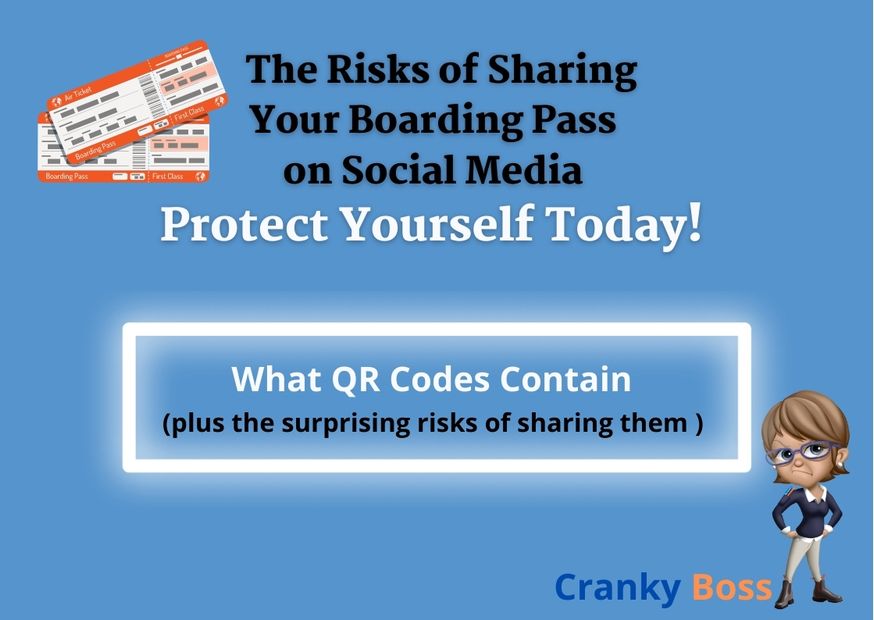Social media has become an integral part of our lives, allowing us to connect with friends and share our experiences. However, we must be mindful of what we post online, especially when it comes to sensitive information like boarding passes. Boarding passes contain QR Codes.
Before we explore why it’s crucial to think twice before sharing your boarding pass on social media let’s first understand what a QR Code is.
What is a QR Code?
A QR code, short for Quick Response code, is a two-dimensional barcode that can be scanned using a smartphone or a QR code reader. It is capable of storing a significant amount of information in a small, square-shaped pattern.
On a boarding pass, the QR code typically contains essential travel details related to the specific flight. These details may vary slightly depending on the airline, but generally include:
- Flight Information: The QR code contains the flight number, departure and arrival airports, and the scheduled departure and arrival times. This information helps airline staff and security personnel identify your flight and ensure a smooth travel experience.
- Passenger Information: The QR code may also include personal information such as your name, seat assignment, and frequent flyer number. This helps the airline staff manage passenger seating and loyalty program benefits effectively.
- Ticketing Information: The QR code can contain details related to your ticket, including the ticket number, class of service (economy, business, etc.), and any special requests or accommodations you may have made during the booking process.
- Security Information: To enhance security measures, the QR code may contain encrypted data that helps verify the authenticity of the boarding pass. This can include unique identifiers or cryptographic elements to prevent fraudulent activities.
The purpose of the QR code on a boarding pass is to streamline the check-in process, reduce paper usage, and provide a convenient way for passengers to access their flight information. By scanning the QR code at various checkpoints, such as at the airport entrance, security checkpoints, and boarding gates, airline personnel can quickly validate your identity and verify your travel details.
The Risks of Sharing Your Boarding Pass
Let’s now explore why it’s crucial to think twice before sharing your boarding pass on social media, as it can have serious consequences for your privacy, security, and even physical safety. It is one of the top ten travel safety tips you should be aware of. I know you are eager to show the world you are flying business or first class in one of the worlds best airlines, but hold up! You need to know this information first.
Personal Information Exposure
When you post your boarding pass on social media, you unwittingly reveal a significant amount of personal information to the public eye. I’ve seen passengers take snapshots intended to show they received the dreaded SSSS code on their boarding pass and inadvertently exposing the whole boarding pass including their QR code. Boarding passes contain details such as your name, flight number, seat assignment, and travel dates. Cybercriminals can exploit this information for various malicious purposes. These Include identity theft, phishing scams, and unauthorized access to your personal accounts.
Privacy Breach and Social Engineering
By sharing your boarding pass, you provide potential attackers with valuable insights into your travel plans. They can use this information to track your whereabouts, ascertain when your home might be vacant, or even target you for theft or other crimes. Additionally, sophisticated scammers can leverage the data from your boarding pass to carry out social engineering attacks, attempting to manipulate you into revealing further personal information or gaining access to your accounts.
Frequent Flyer Account Vulnerabilities
Many airlines link boarding passes to frequent flyer accounts, which hold sensitive information like passport details and credit card numbers. When you publicly share a boarding pass, you increase the risk of unauthorized access to these accounts. Cybercriminals may attempt to exploit this information to gain control over your loyalty program rewards. Furthermore they may make unauthorized purchases, or conduct fraudulent activities, resulting in financial loss and potential legal troubles.
Digital Identity Theft
Posting your boarding pass on social media increases the likelihood of falling victim to digital identity theft. Scammers can easily combine the information from your boarding pass with data from other online sources to build a more complete profile of you. This information can then be used to impersonate you, commit financial fraud, or even open new accounts in your name. Protecting your digital identity is vital, and refraining from sharing your boarding pass online is a crucial step in preventing such crimes.
Physical Safety Risks
Sharing your boarding pass on social media can pose physical safety risks, especially during travel. Malicious individuals could use your boarding pass information to track your location, enabling them to monitor your movements and potentially harm you or your property. It is essential to remember that not everyone on social media has good intentions. By keeping your travel plans private, you can significantly reduce the chances of becoming a target.
Conclusion
As tempting as it may be to share your boarding pass on social media, the potential risks far outweigh any momentary satisfaction. Protecting your privacy, security, and physical safety should always be a priority. By refraining from posting your boarding pass online, you safeguard your personal information. You reduce the chances of identity theft, and minimize the risk of becoming a victim of cybercrime or physical harm. This is particularly important for solo travellers. In fact, once you are done travelling shred your boarding passes and dispose of them completely. Remember, it’s better to err on the side of caution and enjoy your travel experiences without compromising your well-being. And whilst we are on the topic of travelling don’t forget to check out my complete travel packing list which includes items that you wouldn’t think of!

